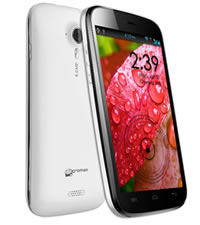Difference between Asus FonePad and Micromax A116 Canvas HD
Key Difference: Asus has announced the launch of newest phablet, the Asus Fonepad. The Fonepad is a 7-inch Android tablet that allows users to also make phone calls by placing the device on their ear. The phablet sports a 7-inch IPS LED backlit touch screen that allowed multitouch capability for up to 10 people. The screen has a resolution of 1280 x 800, which provides approximately 216 ppi density, a decent enough resolution. The Micromax A116 Canvas HD is the successor to the really popular Micromax A110 Canvas 2 and is better than its predecessor in every way. It features a 5.0 inch display with a resolution of 720 x 1280 pixels. It runs on a Quad-core 1.2 GHz Cortex-A7 and 1 GB of RAM.
 Asus has announced the launch of newest phablet, the Asus Fonepad. The company states that the purpose of launching this phone is to bridge the gap between the phone and the tablet, eliminating the need for the carrying to separate devices. The Asus Fonepad is practically a tablet that has phone call making capabilities. The Fonepad is a 7-inch Android tablet that allows users to also make phone calls by placing the device on their ear. Some people may find it silly to place such a huge device on their ear to make calls; for those people the tablet does allow connectivity with a Bluetooth device.
Asus has announced the launch of newest phablet, the Asus Fonepad. The company states that the purpose of launching this phone is to bridge the gap between the phone and the tablet, eliminating the need for the carrying to separate devices. The Asus Fonepad is practically a tablet that has phone call making capabilities. The Fonepad is a 7-inch Android tablet that allows users to also make phone calls by placing the device on their ear. Some people may find it silly to place such a huge device on their ear to make calls; for those people the tablet does allow connectivity with a Bluetooth device.
The Asus Fonepad has borrowed a bunch of features from the Nexus 7, which was also created under Google and Asus collaboration. The weight, dimension and the display are all similar to the Nexus 7; however, the company has replaced the back. The plastic-leather back of the Nexus 7 has been replaced with a slick, steel casing. The device is available in titanium gray and champagne gold colors. The phablet sports a 7-inch IPS LED backlit touch screen that allowed multitouch capability for up to 10 people. The screen has a resolution of 1280 x 800, which provides approximately 216 ppi density, a decent enough resolution. Under the hood, the phablet runs on 1.2 GHz single-core Intel Atom processor, making it pretty fast for multi-tasking, along with playing some high-res games. The device has 1 GB RAM.
There will be two versions of the tablet, one for Europe, the other for Asia. The launch regarding rest of the World has yet to be revealed. The European variant will have 16 GB internal storage capacity, with no rear camera. However, the Asian variant will 8 GB internal storage capacity and will house a 3.2 MP rear camera. Both the variants will house 1.2 MP front camera for video conferencing. The phablet will not support 4G capabilities. The phablet will be available with preloaded Android v4.1 Jelly Bean, with no announcements yet regarding if it is upgradeable to the newest version. The internal storage capacity can expanded up to 32 GB using a MicroSD. One of the most prominent features of the phablet is the massive battery that has been mounted on the device. The non-removable Li-Ion 4270 mAh battery allows the phone to support 32.5 hours of talktime on 3G and 751 hours of standby time. There is no proper release date for the phone, with the expected release to be around April or May 2013.
 Micromax is one such company that has made it a point to offer high-range features on low- and mid-range phones. These phones are appealing to the eyes and do not require such heavy investment. These phones have become disposable, to be used until something better comes along. Such phones include the Micromax A116. It has been known to give excellent competition to Karbonn phones, Samsung mid-range phones and is even beating out Nokia phones. Samsung Galaxy Grand is a mid-range phone that is launched by Samsung Corporation.
Micromax is one such company that has made it a point to offer high-range features on low- and mid-range phones. These phones are appealing to the eyes and do not require such heavy investment. These phones have become disposable, to be used until something better comes along. Such phones include the Micromax A116. It has been known to give excellent competition to Karbonn phones, Samsung mid-range phones and is even beating out Nokia phones. Samsung Galaxy Grand is a mid-range phone that is launched by Samsung Corporation.
The Micromax A116 Canvas HD is the successor to the really popular Micromax A110 Canvas 2 and is better than its predecessor in every way. It features a 5.0 inch display with a resolution of 720 x 1280 pixels. It runs on a Quad-core 1.2 GHz Cortex-A7 and 1 GB of RAM, making is faster than its predecessor and most mid-market smartphones at the time. It comes with Android OS v4.1.2 (Jelly Bean), and has a planned upgrade to v4.2 (Jelly Bean). Like its predecessor, it is also a Dual-SIM phone and has an internal memory of 4 GB, of which 1.77 GB is available to the user. The phone has an 8 MP primary camera and a 2 MP secondary camera.
The information for the detailed table about the two phones has been taken from the Asus website, trustedreviews.com, pcworld.idg.com.au, Micromax website, flipkart.com and GSMArena.com.
|
|
Asus Fonepad |
Micromax A116 Canvas HD |
|
Launch Date |
Expected April 2013 |
February 2013 |
|
Company |
Asus |
Micromax |
|
Size |
196.4 x 120.1 x 10.4 mm |
144 x 74 x 10.7 mm |
|
Display |
7" LED Backlight WXGA IPS Panel touch screen |
5.0 inches IPS LCD capacitive touchscreen, 16M colors |
|
Screen |
1280x800 (~216 ppi pixel density) |
720 x 1280 pixels, (~294 ppi pixel density) |
|
Protection |
N/A |
Yes |
|
Weight |
340 g |
156 g |
|
2G Network |
GSM 850 / 900 / 1800 / 1900 |
GSM 900 / 1800 - SIM 1 & SIM 2 |
|
3G Network |
WCDMA: 850/900/1900/2100 HSDPA 850 / 900 / 1900 / 2100 |
HSDPA 2100 |
|
4G Network |
N/A |
N/A |
|
GUI |
Asus UI |
Custom UI |
|
CPU speed |
1.2 GHz Single-core Intel Atom |
Quad-core 1.2 GHz Cortex-A7 |
|
GPU |
PowerVR SGX540 |
PowerVR SGX544 |
|
OS |
Android OS v4.1 (Jelly Bean) |
Android OS, v4.1.2 (Jelly Bean), planned upgrade to v4.2 (Jelly Bean) |
|
Chipset |
Intel Atom Z2420 |
MTK MT6589 |
|
RAM |
1 GB |
1 GB RAM |
|
SIM Size |
microSIM |
Dual SIM (Mini-SIM) |
|
Internal Memory |
8/16 GB |
4 GB (1.77 GB user available) |
|
Expandable Memory |
Up to 32 GB |
microSD, up to 32 GB |
|
Sensors |
GPS & Glonass,G-Sensor, E-compass, Proximity, Ambient Light Sensor |
Proximity sensor, Motion sensor, Gravity sensor, Light sensor |
|
Connectivity |
GSM, HSDPA, WCDMA, Bluetooth, USB, WLAN802.11 |
3G , Bluetooth 4.0 , Wi-Fi , USB 2.0, GSM/GPRS/EDGE, HSPA, HSPA+, GPS |
|
Data |
GPRS, EDGE, WLAN, Bluetooth, USB |
GPRS, EDGE, WLAN, Bluetooth, USB |
|
Speed |
HSDPA 21 Mbps, HSUPA 5.76 Mbps |
GSM/GPRS/EDGE 900/1800 HSPA 2100 MHz HSPA+ (DL-21Mbps, UL-11Mbps) depends upon network |
|
WLAN |
WLAN802.11 b/g/n |
Wi-Fi 802.11 b/g/n, Wi-Fi hotspot |
|
Bluetooth |
Bluetooth V3.0 |
Yes, v4.0 with A2DP |
|
USB |
microUSB v2.0 |
Yes, microUSB v2.0 |
|
Primary Camera |
3.2 MP autofocus camera |
8 MP, 3264 x 2448 pixels, autofocus, dual-LED flash |
|
Secondary Camera |
1.2 MP |
Yes, 2 MP |
|
Video |
720p |
Yes, 720p@30fps |
|
Camera Features |
Autofocus |
Geo-tagging, touch focus, face detection |
|
Sound Enhancement |
Active noise cancellation with dedicated mic; Asus Sonice Master audio technology with MaxxAudio 3 by Waves |
No |
|
Audio supported formats |
MP3/WAV/eAAC+ player |
MP3/AAC/WMA/WAV player |
|
Video supported formats |
MP4/H.264/H.263 player |
MP4/WMV/H.264/H.263 player |
|
Battery Capacity |
Non-removable Li-Ion 4270 mAh battery (16 Wh) |
Li-Ion 2000 mAh battery |
|
Talktime |
3G: 32.5 hours |
2G: 5 hours |
|
Standby Time |
3G: 751 hours |
2G: 174 hours |
|
Available Colors |
Titanium Gray, Champagne Gold |
Black, White |
|
Messaging |
SMS(threaded view), MMS, Email, Push Email, IM |
SMS(threaded view), MMS, Email, Push Email, IM |
|
Browser |
HTML5 |
HTML5 |
|
Radio |
No |
FM radio |
|
GPS |
GPS, A-GPS, Glonass |
Yes, with A-GPS support |
|
Java |
Yes, via Java MIDP emulator |
Yes, via Java MIDP emulator |
|
Additional Features |
|
|
Image Courtesy: asus.com, fonearena.com









Add new comment